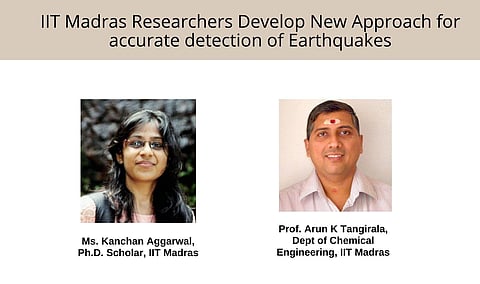

Could the Fukushima Daiichi nuclear disaster have been averted? The natural calamity in 2011 in Japan was a result of a 9.0 magnitude earthquake that then caused a devastating tsunami in the Pacific Ocean. The thing about earthquakes is that the seismographs we have today cannot detect the very first, non-destructive wave, which can leave us with an invaluable fraction of a minute to shut down nuclear power plants or stop elevators or pull the plug on public transport services such as the Metro. While the case of the Fukushima nuclear reactor was complicated because of the tsunami, it does serve as an example for the far-reaching impact that an early detection of an earthquake can cause.
It was exactly this window of time that captivated PhD scholar Kanchan Agarwal when she joined IIT Madras as a project associate in 2015. Fast forward six years later, and now, Kanchan and her team at IIT M have developed a new approach that can help detect the first benign wave of a potentially devastating earthquake that can provide us with the time to minimise damage. The research was funded by the Bhabha Atomic Research Centre and published in the peer-reviewed scientific journal, PLOS One.
Curiosity can shift mountains. And in Kanchan's case, it has turned out to be nothing short of a driving force. Fresh out of a Bachelor's in Technology in Electronics and Instrumentation, Kanchan met Prof Arun K Tangirala, Department of Chemical Engineering, who steered her towards a question that seismologists have struggled over the years to answer. How do you detect an earthquake fast enough to prevent damage?
Kanchan knew precious little about the field of seismology, but as a native of Meerut, Uttar Pradesh, she had had some close shaves with minor earthquakes. "Understanding the physics behind the process was a daunting challenge, but it was also what piqued my interest in the project," says the 28-year-old, adding, "I was allowed to research and figure out on my own how earthquake signals are recorded and what analysis can be done, and how we can detect one."
In 2016, she joined IIT M for a Postgraduate and PhD dual degree and began working in earnest on the project. She developed her hold on the analysis and processing of seismic signals by taking courses at the institute, reading up to gain a basic understanding of the signal, core nature of each wave, and how it is being generated and engaging in detailed discussions on the subject with her professors, including Prof Arun.
Earthquake detection is not as simple as getting a reading off of the Richter scale, which is most commonly known. There are different types of scales that measure different parts of a tectonic activity that causes earthquakes. These include the Richter scale, the Mercalli Scale, the Moment Magnitude Scale, and a couple of others. Kanchan's team experimented with the idea of combining time-frequency, or predictive tools, which can measure the time-lapse of seismic activity, and the signal detection, which is a multi-scale system, to reach a more accurate detection rate.
"The approach helps detect seismic signal P-wave with high accuracy rate. False alarm rate is also reduced because of the time-frequency localisation feature," says Kanchan. The predictive models are developed to detect seismic noise when there is no event or earthquake, after which a model is developed to keep predicting noise based on that pattern. And in the event of an earthquake, the deviation from the prediction and the actual noise will alert the user to a P-wave or the first wave of the tremor.
"To improve prediction and reduce fall alarm rate, we decomposed the predictions and the actual data into the time-frequency domain using a tool called Wave Length Package Transformation. It segregates data into higher and lower frequency ranges, and then it becomes easy to pick out frequency bands in which we know that P-wave can occur. P-wave frequency cannot go beyond two hertz. Because of this localisation feature, we were able to detect an earthquake of a low magnitude, as low as .6 magnitude. the existing technology fails to detect that mild an earthquake," explains Kanchan who currently works at Honeywell, a US-based tech development company. She hopes to finish her PhD in the next couple of months.
The approach is but an algorithm at this point, and further expertise and polishing are required for it to take the form of a device at a seismic station. That is Kanchan's dream, though, and she is confident about her creation outshining the existing ones because she's had it tested on real-time earthquake data.
The approach can be used in any process where an anomaly needs detection. The dynamic nature of the innovation is such that it need not be restricted to the field of seismology, but can be used in any area that requires the detection of an anomaly.
